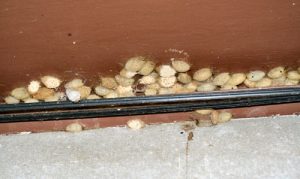Introduction
This Spring has been very favorable for several moth species, and among them is the Tussock Moth. You may be seeing a profuse amount of the moth caterpillars around your home, work or farm. The major host of this caterpillar is oak; however, feeding rarely results in serious tree damage even though the moths are present when the trees have new leaves emerging. Saplings and small shrubs in the landscape may be severely affect but the moths can be removed with a simple garden hose spray.
Life Cycle
Moths hatch from eggs in the spring (February – March). After feeding, moths will form cocoons (Figure 1) and attach them to all sorts of items in your landscape (occurs in April). Adult males will emerge from cocoons to reproduce with the wingless females, who remain in their cocoons until they lay eggs and die. There are three species of tussock moth found in Florida; Orgyia detrita (the fir tussock moth, Figure 2) is the most common, followed by Orgyia leucostigma (the whitemarked tussock moth) and lastly Orgyia definita (the definite tussock moth). Two of these species have two generations per year and the other species will go through only a single generation.


Identification
Tussock moth species can vary in appearance slightly, but have very common features that make them recognizable. The most common species, O. detrita, has a prominent red head and very stiffly bristled, black antennae. Another unique feature of tussock mots are the four white tufts of dense hair (tussocks) arising from the back. On the abdomen of the caterpillar is a single, tail-like appendage made of stiff black bristly hairs. Orange spots appear on the back and sides of O. detrita (Figure 2). O. leucostigma, also has a red head, three hairy tail-like appendages and four white tussocks; they are distinguished by their lighter body color and yellow spots. O. definita, though rarely found in this area, has a yellow or tan head.
Management
Mechanical Removal
-
- Cocoons, eggs and caterpillars can be removed from objects and plants by brushing them or spraying them with water.
Chemical Control
-
- Insecticides that are used to control caterpillars are effective against tussock moths. However, exposure occurs through feeding on plant foliage so timing is key to effective treatment. Ideally, treatments would occur when the caterpillars have just emerged from their eggs. Insects are protected in their egg and pupae forms and insecticides are ineffective against controlling insects that are in these life stages.
- Tussock moth hairs can be irritating to the skin. Eye, skin, and ventilation protection should be used when removing the insects.
Reference Links
The Tussock Moth – UF/IFAS Entomology and Nematology, Featured Creatures
Tussock Moth Caterpillars in Northcentral Florida – UF/IFAS
 0
0

Comments are closed.